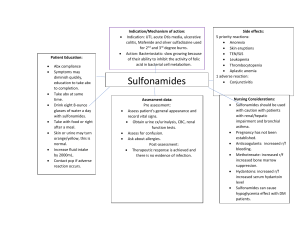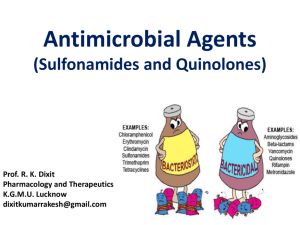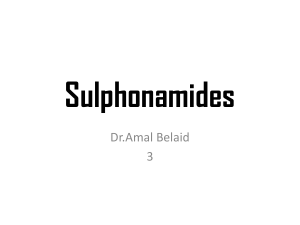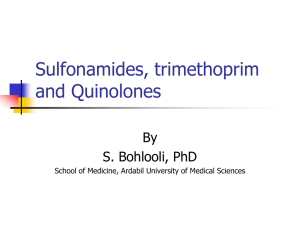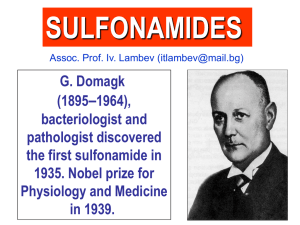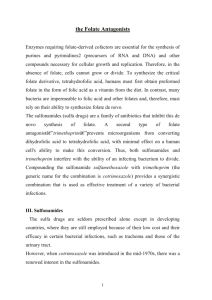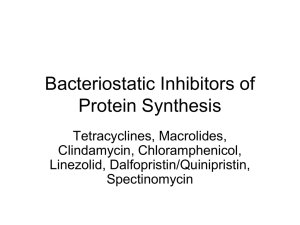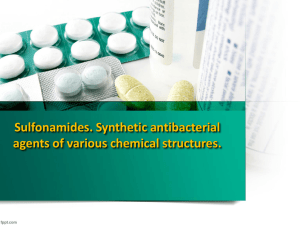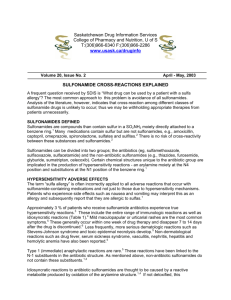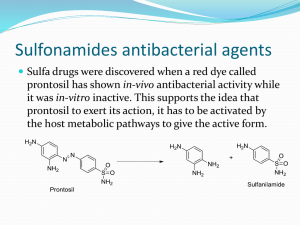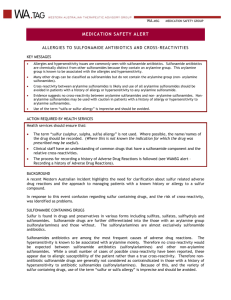SULFONAMIDES and TRIMETHOPRIM
advertisement
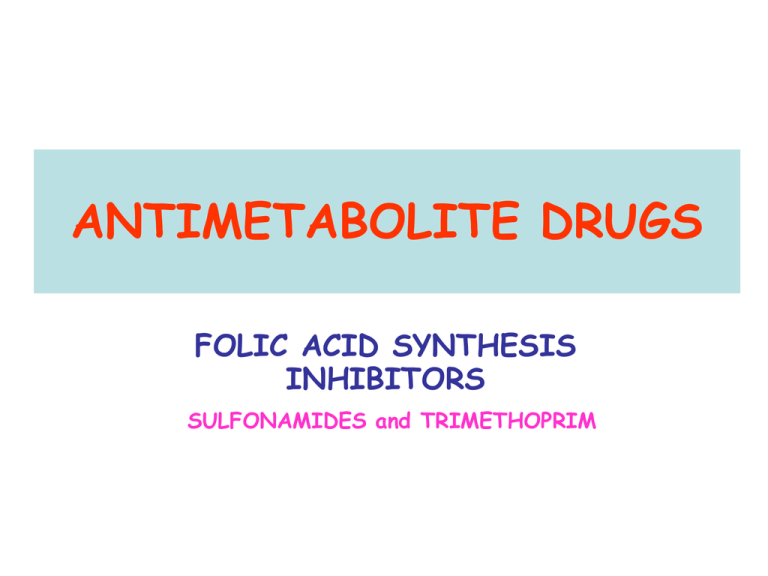
ANTIMETABOLITE DRUGS FOLIC ACID SYNTHESIS INHIBITORS SULFONAMIDES and TRIMETHOPRIM MECHANISM OF ACTION OF VARIOUS ANTIMICROBIALS Folate synthesis inhibitors ANTIFOLATE DRUGS CLASSIFICATION AND PHARMACOKINETICS Sulfonamides The sulfonamides have a common chemical nucleus resembling p-aminobenzoic acid (PABA). SULFONAMIDES ORALLY ABSORBABLE short acting sulfisoxazole, intermediate acting sulfamethoxazole, long acting sulfadoxine ORALLY NONABSORBABLE Sulfaguanidine, sulfasalazine weakly absorbed after oral intake and used in the treatment of enteric infections TOPICAL Sulfadiazine is used in burns topically, Sulfacetamide in ophthalmic preparations PK Absorbed from the stomach and small intestine → distributed widely to tissues and body fluids CNS, CSF, placenta, fetus Hepatic metabolism → acetylated or glucuronidated and excreted in the urine ANTIFOLATE DRUGS MECHANISMS OF ACTION 1. Sulfonamides • The sulfonamides are bacteriostatic inhibitors of folic acid synthesis. • As antimetabolites of PABA, they are competitive inhibitors of dihydropteroate synthase. • The selective toxicity of sulfonamides results from the inability of mammalian cells to synthesize folic acid; they must use preformed folic acid that is present in the diet. ANTIMETOBOLITE ANTIBIOTICS They inhibit the folic acid synthesis p-Aminobenzoic acid (PABA) Dihydropteroate synthase Sulfonamides (compete with PABA) Dihydrofolic acid Dihydrofolate reductase Trimethoprim, pyrimethamine Tetrahydrofolic acid Purines DNA TRIMETHOPRIM & PYRIMETHAMINE ANTIFOLATE DRUGS CLASSIFICATION AND PHARMACOKINETICS-2 Trimethoprim • This drug is structurally similar to folic acid. • It is a weak base and is trapped in acidic environments, reaching high concentrations in prostatic and vaginal fluids. • A large fraction of trimethoprim is excreted unchanged in the urine. • The half-life of this drug is similar to that of sulfamethoxazole (10—12 h). ANTIMETOBOLITE ANTIBIOTICS CLINICAL USE 1. Sulfonamides (now rarely used by themselves) • They are active against gr(-) and gr(+) organisms • They are used for the condition that: simple urinary tractsulfisoxasole ocular infections sulfacetamide burn infections silver sulfadiazine ulcerative colitis rheumatoid arthritis sulfasalazine toxoplasmosis oral sulfasalazine plus pyrimethamine (a dihdyrofolate reductase ANTIFOLATE DRUGS MECHANISMS OF ACTION-2 2. Trimethoprim • Trimethoprim is a selective inhibitor of bacterial dihydrofolate reducate that prevents formation of the active tetrahydro form of folic acid. 3. Trimethoprim plus sulfamethoxazole • When the 2 drugs are used in combination, antimicrobial synergy results from the sequential blockade of folate synthesis. • The drug combination is bactericidal against susceptible organisms RESISTANCE Production of a mutated dihydropteroate synthetase that has reduced affinity for binding of sulfonamides. Resistance is transmitted among Gram-negative bacteria by plasmids. Resistance in Staphylococcus aureus occurs as a result of xessive synthesis of PABA. Some resistant bacteria have reduced uptake of sulfonamides. Bacteria which utilize exogenous folic acid are resistant to sulfonamides. ANTIMETOBOLITE ANTIBIOTICS CLINICAL USE-2 2. Trimethoprim-sulfamethoxazole (TMP-SMX) is effective against P jiroveci pneumonia, shigellosis, systemic salmonella infections, uti, prostatitis, respiratory pathogens pneumococcus, H.influenzae and Moraxella catarrhalis • TMP-SMX is also the drug of choice in nocardiosis, a possible backup drug for cholera, typhoid fever, and shigellosis, and has been used in the treatment of infections caused by methicillin-resistant staphylococci and Listeria monocytogenes. ANTIMETOBOLITE ANTIBIOTICS TOXICITY 1. Sulfonamides • Hypersensitivity: allergic reactions including skin rashes and fever. Cross allergy may occur wit chemically related drugs (thiazides, hypoglycemics) • GI: nausea, vomiting and diarrhea • Hematotoxicity: they are rare. Granulocytopenia, thrombocytopenia and aplastic anemia • Nephrotoxicity: they may precipitate in the urine at acidic pH, causing crystalluria and • ANTIMETOBOLITE ANTIBIOTICS TOXICITY-2 Trimethoprim • Trimethoprim may cause the predictable adverse effects of an antifolate drug, including megaloblastic anemia, leukopenia, and granulocytopenia. • These effects are usually supplementary folinic acid. • The combination of TMP-SMX may cause any of the adverse effects associated with the sulfonamides. • AIDS patients given-SMX have a high incidence of adverse effects, including fever, rashes, ameliorated by ANTIMETOBOLITE ANTIBIOTICS DRUG INTERACTION • Competition with warfarin, hypoglycemic drugs sulfonylureas, phenytoin and methoteraxate for plasma protein binding transiently increases the plasma levels of these drugs • Sulfonamides can displace bilurubin from plasma proteins, with the risk of kernicterus in the neonate if use in the third trimester of pregnancy BACTERIAL RESISTANCE A rapidly increasing problem. However, it is lower with the combination compared to agents used alone. In a survey of children in Memphis Tennessee 29% isolates were penicillin resistant, and 25% of these were resistant to TMP-SMZ. Emergence of TMP-SMZ resistant S.aureus and Enterobacteriaceae is a serious problem in AIDS patients! Resistance is often due to the acquisition of a plasmid that codes for an altered dihydrofolate reductase.
